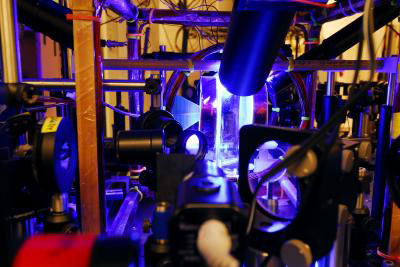| Feb 15, 2012 |
$8.5 million research initiative will study best approaches for quantum memories
|
|
(Nanowerk News) The U.S. Air Force Office of Scientific Research (AFOSR) has awarded $8.5 million to a consortium of seven U.S. universities that will work together to determine the best approach for generating quantum memories based on interaction between light and matter.
|
|
The team will consider three different approaches for creating entangled quantum memories that could facilitate the long-distance transmission of secure information. The five-year Multidisciplinary University Research Initiative (MURI) will be led by the Georgia Institute of Technology and include scientists from Columbia University, Harvard University, the Massachusetts Institute of Technology, the University of Michigan, Stanford University and the University of Wisconsin.
|
|
"We want to develop a set of novel and powerful approaches to quantum networking," said Alex Kuzmich, a professor in Georgia Tech's School of Physics and the MURI's principal investigator. "The three basic capabilities will be (1) storing quantum information for longer periods of time, on the order of seconds, (2) converting the information to light, and (3) transmitting the information over long distances. We aim to create large-scale systems that use entanglement for quantum communication and potentially also quantum computing."
|
 |
| This image shows experimental equipment used to study quantum information systems in the laboratory of Alex Kuzmich at the Georgia Institute of Technology.
|
|
The MURI scientists will study three different physical platforms for designing the matter-light interaction used to generate the entangled photons. These include neutral atom memories with electronically-excited Rydberg-level interactions, nitrogen-vacancy (NV) defect centers in diamonds, and charged quantum dots.
|
|
"A large body of work has been initiated in this area over the past 15 years by our team members and their research groups," Kuzmich noted. "The physical approaches are different, but the goals are closely related, so there are significant opportunities for synergistic activities. Through this MURI, we will be able to interact more closely, communicate more quickly and provide new opportunities for our students and postdoctoral fellows."
|
|
Overall, the MURI has four major goals:
|
|
To implement efficient light-matter interfaces using three different approaches to entanglement;
To realize entanglement lifetimes of more than one second in both the nitrogen-vacancy centers and atomic quantum memories;
To implement two-qubit quantum states within memory nodes;
To integrate different components and physical implementations into small units capable of significant quantum processing tasks.
|
|
Quantum memories generated from the interaction of neutral atoms and light now have maximum lifetimes of approximately 200 milliseconds. But improvements beyond memory lifetime will be needed before practical systems can be created.
|
|
"We aim to be able to combine systems, so that instead of just one memory entangled with one photon, perhaps we could have four of them," Kuzmich added. "This may look like a straightforward thing to do, but this is not easy in the laboratory. The improvements must be made at every level, so the difficulty is significant."
|
|
Among the challenges ahead are maintaining separation between the different memory systems, and minimizing loss of light as signals propagate through the optical fiber systems that would be used to transmit entangled photons.
|
|
"Light is easily lost, and there's not much that can be done about that from a fundamental physics standpoint," said Kuzmich. "The rates of these protocols go down rapidly as you try to scale up the systems."
|
|
Kuzmich and his Georgia Tech research team have been developing quantum memory based on the interaction of light with neutral atoms such as rubidium. They have made substantial progress over the past decade, but he says it's not clear which approach will ultimately be used to create large-scale quantum communication system.
|
|
The most immediate applications for the quantum memory are in secure communications, in which the entanglement of photons with matter would provide a new form of encryption.
|
|
"The immediate focus is on communication, including memories and distributed systems, which is important for sharing and transmitting information," Kuzmich explained. "It also has implications for quantum computation because similar techniques are often used."
|
|
"If we are successful with this over the next five years, long-distance quantum communications may become promising for real-world implementation," Kuzmich added. "Integrating these advances with existing infrastructure ? optical fiber that's in the ground ? will continue to be an important engineering challenge."
|

